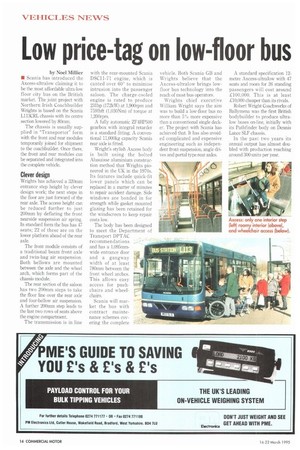Low price-tag on low-floor bus
Page 16

If you've noticed an error in this article please click here to report it so we can fix it.
by Noel Millier • Scania has introduced the Axcess-ultralow claiming it to be the most affordable ultra-low floor city bus on the British market. The joint project with Northern Irish Coachbuilder Wrights is based on the Scania L113CRL chassis with its centre section lowered by 80mm.
The chassis is usually supplied in "Transporter" form with the front and rear modules temporarily joined for shipment to the coachbuilder. Once there, the front and rear modules can be separated and integrated into the complete vehicle.
Clever design Wrights has achieved a 320mm entrance step height by clever design work; the next steps in the floor are just forward of the rear axle. The access height can be reduced further to just 200mm by deflating the front nearside suspension air spring. In standard form the bus has 47 seats; 22 of these are on the lower platform ahead of the rear axle.
The front module consists of a traditional beam front axle and twin-bag air suspension. Both bellows are mounted between the axle and the wheel arch, which forms part of the chassis module.
The rear section of the saloon has two 200mm steps to take the floor line over the rear axle and four-bellow air suspension. A further 200mm step leads to the last two rows of seats above the engine compartment.
The transmission is in line with the rear-mounted Scania DSC11-71 engine, which is canted over 60= to minimise intrusion into the passenger saloon. The charge-cooled engine is rated to produce 231hp (172kW) at 1,900rpm and 7591bft (1,030Nm) of torque at 1,20Orpm.
A fully automatic ZF4HP500 gearbox with integral retarder is a standard fitting. A conventional 11,000kg capacity Scania rear axle is fitted.
Wright's stylish Axcess body is built using the bolted Alusuisse aluminium construction method that Wrights pioneered in the UK in the 1970s. Its features include quick-fit lower panels which can be replaced in a matter of minutes to repair accident damage. Side windows are bonded in for strength while gasket mounted glazing has been retained for the windscreen to keep repair costs low.
The body has been designed to meet the Department of Transport DPTAC recommendations and has a 1,095mmwide entrance door and a gangway width of at least 780mm between the front wheel arches. This allows easy access for pushchairs and wheelchairs.
Scania will market the bus with contract maintenance schemes covering the complete vehicle. Both Scania GB and Wrights believe that the Axcess-ultralow brings lowfloor bus technology into the reach of most bus operators.
Wrights chief executive William Wright says the aim was to build a low-floor bus no more than 5"•,, more expensive than a conventional single decker. The project with Scania has achieved that. It has also avoided complicated and expensive engineering such as independent front suspension, angle drives and portal type rear axles.
A standard specification 12metre Axcess-ultralow with 47 seats and room for 26 standing passengers will cost around £100,000. This is at least £.10,000 cheaper than its rivals.
Robert Wright Coachworks of Ballymena was the first British bodybuilder to produce ultralow buses on-line, initially with its Pathfinder body on Dennis Lance SLF chassis.
In the past two years its annual output has almost doubled with production reaching around 300 units per year.




















































































































